THE PLIGHT OF YANOMANI

Yanomani Customs
Since the Yanomami are isolated in the forest with almost no contact with different human beings, they have developed their own customs which they preserve. Many of these traditions would be considered as strange, but to the Yanomami, their traditions are common and ordinary.
VILLAGES
The Yanomami live with hundreds of families all clustered in one immense hut, known as a shabono. A shabono has a cylindrical structure with a flat cone-shaped roof with a large open area in the middle. An open area is constructed as the Yanomami believe it is to respect the gods above. Shabonos are made from resources from the jungle such as leaves, vines and tree trunks and these materials help prevent rain from soaking inside the shabono. Nonetheless, villagers need to rebuild a new shabono every 1 to 2 years to preserve the stableness of their homes. Since the shabono has no sign of individual homes, to make a distinction the different families in one shabono, support posts are constructed under the roof to show the particular spaces.
Every Yanomami in that extensive hut hunts throughout the forest, varying in range, with a family always sticking together. Although villages do interact with one another, they are usually an extremely extended length between each other which can take up to a ten day walk! The Yanomami’s village commonly includes both children and adults however different villages vary in the population, containing from 50 to 400 people.











MEN
In the Yanomami society, the men travel deep into the forest for several months to hunt. There they will hunt for peccari, tapir, monkeys, crabs, fish, frogs and caiman and with the addition of wild plants that are edible. Men use bows and arrows for hunting while hooks and line for fishing. They would have learnt and developed their hunting skills when they were toddlers, as they spent around 3 hours a day tracking, stalking, and playing with bows and arrows.
Yanomami men furthermore chop wood to build and construct the Shabonos but also harvest food with the women. When men go to war, they paint each other in black paint to show night and death, and additionally, they customarily wear bracelets made of feathers or flowers habitually.

WOMEN
Maturity Age
Up to the time where the female Yanomami get their first menstrual period, they are considered as children and when they advance towards the age of menstruation, they are promised to another man as a potential wife. When a she receives her first period, their mothers are informed instantly along with the girl’s older female friends. She and her elder friends are then obliged to discard her clothes and replace them with new clothes to represent the start of womanhood. Throughout the week of her first menstrual period, the female is only permitted to eat with a stick and is forbidden to have contact with food by touching. When the female needs to talk, it can only speak to her siblings or parents, but never to a male. After her first period, the female Yanomami are considered to have left childhood and is entering adulthood and its responsibilities. Additionally, after their first menstruation, they are prohibited to show their genitalia and must cover it.
Duties
Women in a Yanomami tribe are accountable for all chores and duties, eliminating hunting and killing game for food. They are the gardeners in the Yanomami society and collect small amounts of food when the men are out hunting. The other half of women who are not gathering small amounts of food spend a long period of time fishing. Occasionally, women hunt for frogs, land crabs, caterpillars or search for vines that can be adequately woven into a basket. The gardening areas are organised by the different families and crops vary from bananas, sugarcanes, mangoes, sweet potatoes, papaya, and maniocs. The females plough the garden area until it is not fertile anymore and move to another more fertile location. The women are then expected to carry up to 80 pounds of crops on their backs in bark straps woven together, when harvesting.
Childbearing
Yanomami females are required to raise children until maturity age. The maturity age for females would be when she receives her first menstrual period (usually between 10 and 12 years of old) while there is not a significant time period when they reach maturity.
Baskets
In the Yanomami tribe, women weave and decorate baskets. Baskets are made for collecting and gathering crops to carry back to the village. Using small stings of barks, roots and vines, they first weave the material into a basket. They then use a type of red berry to paint the baskets into a blood red colour. This re berry is further used to paint the Yanomam bodies and to dye their loin clothes. After the red berry is applied, masticated charcoal pigment is used to decorate the basket to generate a pleasant and finished basket.
CHILDREN
Children in the Yanomami society remain within close reach of their mothers as their mothers take the most care of their children. Children and their mother hunt for termite nests and other grubs in the mornings which would be roasted. The young children will then help their mothers to do domestic chores and duties for the rest of the day. However, Yanomami mothers usually seek help from their daughters more as the young boys play around with bows and arrows to develop their future hunting skills.
HEADSMEN
Every Yanomami community has its own rules and there will always be either one or more headsmen. The headsmen job includes by settling and calming fights, making allies with other Yanomami tribes and leads his village into wars. Headsmen may be bullies while others are very convincing however, the headsmen always manages fights calmly and always ensures no one is injured. Men are commonly more respected when they enter battle, storytelling and shamanism and thus men have a more major role in authority and religion.
 Fishing | 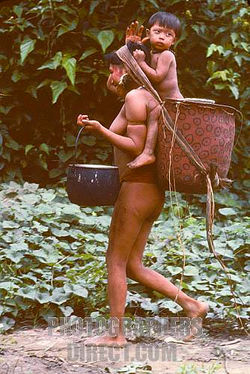 Bringing Back Crops with Child |  Childbearing |
|---|---|---|
 Childbearing & Gardening |  Painting with Red Berries |  Matured Woman |
 Baskets |  Adult Women |  Collecting Small Amounts of Food |
 Childbearing |  Constructing a Basket |


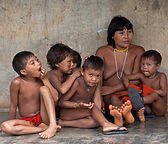


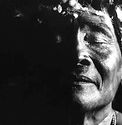
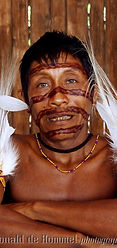





MARRIAGE
In Yanomami custom, marriage commemorations do not occur and are not commonly memorialized. Practices where a man has many wives are extremely ordinary and common in the Yanomami lifestyle. A young girl in the Yanomami society can be pledged to a man and can only be officially married after their first menstrual period. The reason for this is because the menstrual cycle for the Yanomami is very rare and unique due to constant nursing or child birthing. Thus, the menstrual period is treated with extreme honour at this significant time.
After a young girl’s first menstrual period she is officially given by her parents to another man who is customarily a cousin. Marriages between the girl and the sun of a maternal uncle or parental aunt, cross-cousin marriages, are the most habitual marriage. Once a female is handed to her husband, they must execute the same chores and duties they did for their mother but to their spouse.
Chaos and abuse between couples are very frequent and when the female feels she can no longer live with her husband, she may abscond to her brothers.
In the Yanomami tribe, women are anticipated to embrace polygamy. Although the husband is strictly forbidden to show favourites due to jealousy, the eldest wife in a marriage has more dominance over the others. She can act as a boss or as the leader over the other wives but usually has no more sexual relationship ties with her husband.
Marriages where the husband goes to live with the wife’s community, matrilocal marriage is also quite common. However, patrilocal families consist of more importance in the village.
RELIGION
The word urihi is a Yanomami word meaning the forest of the world and also means territory. While thëpë urihipë means the forest of human beings, is what the Yanomami God, Omana, gave to the Yanomami to give birth to new generations forever. For the Yanomami, the forest is where breath is generated and where new organisms come alive and in the Yanomami’s spiritual religion, they believe that humans first originated from animals because of the animal’s bad behaviour.
The Yanomami spirits are acknowledged as xapiripë. Xapiripë are believed to be small sized humans painted in bright colours but can also be found in mammals, birds, fish, amphibians, reptiles, lizards, turtles, crabs and insects. There are also spirits of the nature and environment such as water, thunder and lightning but also daily objects or animals. For instance, the dog spirit and the fire spirit of the clay pot spirit. There are also what the Yanomami call the spirits of “whites”. These spirits are known as the napënapëripë, and they own tamed animals, for example, chickens horses and cattles.
The Yanomami also have shamans’ who the Yanomami depend on for a dominant part of their lives. The Yanomami worship the shamans’ by dancing in a loud and noisy way with other tribes being able to join.
In order for a Yanomami to become a shaman, one must occupy his several days with elder humans breathing in a powder that is in Yanomami legends, the food of spirits. This powder is known as Yãkõana powder which comes from a type of tree called the virola tree. The powder’s symptoms include dizziness, nauseousness, sleepiness and numbness but the powder also creates a sense of humming in the ears and vision. However, the Yanomami is strongly convinced that the powder causes the man’s mortal eyes to be replaced them with a new vision which lets him see the spirits of xapiripë. Thus, the man will be able communicate with the spirits to represent his tribe. In the Yanomami tribe, the Shaman is considered to be an extremely crucial person.
Once a Yanomami dies, it is tradition that a small group of Yanomami men go on a special hunt acknowledged as henimoyu. Later that night, a party is held where the teenage Yanomami dance and chant unique poems. They then burn the dead’s ashes which are eaten by the society in a plain soup. Females cry for the dead while the dead’s friends and families drink the soup.
 30909862.JPG |  yanomami-yopo.jpg |
|---|---|
 Yanomami-shaman-picture.jpg |  Yanomami-10.jpg |
 mg22029430.800-1_1200.jpg |  d_227.jpg |
 claudia-andujar-pb-08_article_column.jpg |


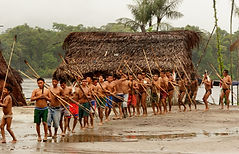
WARRIORS
Although the Yanomami may be peaceful, they are very aggressive and vigorous warriors. Occasionally, the Yanomami kidnap women from the enemy’s so the birth rates in their community increase. Villages that are at war with each other are always days walk from each other while villages at peace are only a few hours away.
When a Yanomami population increases up to 150 people, the Yanomami community usually split, however during war, villages will only split when the Yanomami tribe reaches up to a population of 300 people.
The reasons for war between Yanomami villages are numerous and therefore, war in an extremely dominant part of the Yanomami’s customs. With 40% of Yanomami men having killed another person and 25% of males die from violence.

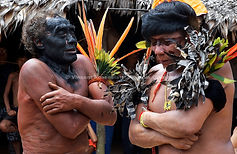

SHIFTING CULTIVATION
The Yanomami regularly loco mote to prevent the overuse of the land. This is scientifically acknowledged as "shifting cultivation" where the earth's soil is worn out and exhausted.
